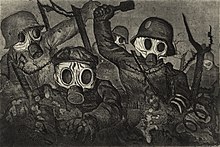Otto Dix
The eldest son of Franz Dix, an iron foundry worker, and Louise, a seamstress[3] who had written poetry in her youth, he was exposed to art from an early age.
[4] The hours he spent in the studio of his cousin, Fritz Amann, who was a painter, were decisive in forming young Otto's ambition to be an artist; he received additional encouragement from his primary school teacher.
[7] In the autumn of 1915 he was assigned as a non-commissioned officer of a machine-gun unit on the Western front and took part in the Battle of the Somme.
He took part in an anti-aircraft course in Tongern, was promoted to Vizefeldwebel and after passing the medical tests transferred to Aviation Replacement Unit Schneidemühl in Posen.
He represented his traumatic experiences in many subsequent works, including a portfolio of fifty etchings called Der Krieg, published in 1924.
At the end of 1918 Dix returned to Gera, but the next year he moved to Dresden, where he studied at the Hochschule für Bildende Künste.
Dix's work, like that of Grosz—his friend and fellow veteran—was extremely critical of contemporary German society and often dwelled on the act of Lustmord, or sexualized murder.
He drew attention to the bleaker side of life, unsparingly depicting prostitution, violence, old age, and death.
"[13] Among his most famous paintings are Sailor and Girl (1925), used as the cover of Philip Roth's 1995 novel Sabbath's Theater, the triptych Metropolis (1928), a scornful portrayal of decadence and depravity in Germany's Weimar Republic,[14] where nonstop revelry was a way to deal with the wartime defeat and financial catastrophe,[15] and the startling Portrait of the Journalist Sylvia von Harden (1926).
His depictions of legless and disfigured veterans—a common sight on Berlin's streets in the 1920s—unveil the ugly side of war and illustrate their forgotten status within contemporary German society, a concept also developed in Erich Maria Remarque's All Quiet on the Western Front.
[21] Dix, like all other practising artists, was forced to join the Nazi government's Reich Chamber of Fine Arts (Reichskammer der bildenden Kuenste), a subdivision of Goebbels' Cultural Ministry (Reichskulturkammer).
After the war most of his paintings were religious allegories or depictions of post-war suffering, including his 1948 Ecce homo with self-likeness behind barbed wire.
In 1959 he was awarded the Grand Merit Cross of the Federal Republic of Germany (Großes Verdienstkreuz) and in 1950, he was unsuccessfully nominated for the National Prize of the GDR.
[27][28][29] The Otto-Dix-Haus was opened in 1991, at the 100th anniversary of Dix's birth, in the 18th-century house where he was born and grew up, at Mohrenplatz 4 in the city of Gera, as a museum and art gallery.
[31] The Museum Haus Dix was inaugurated in 2013 in the house where the artist lived with his family and where he worked from 1936 to 1969, in Hemmenhofen, south Germany.


